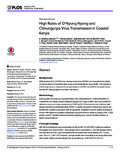High rates of o’nyong nyong and Chikungunya virus transmission in coastal Kenya

View/
Date
2015Author
LaBeaud, A Desiree
Banda, Tamara
Brichard, Julie {et al}
Metadata
Show full item recordAbstract
Chikungunya virus (CHIKV) and o’nyong nyong virus (ONNV) are mosquito-borne alpha-viruses endemic in East Africa that cause acute febrile illness and arthritis. The objectives of this study were to measure the seroprevalence of CHIKV and ONNV in coastal Kenya and link it to demographics and other risk factors.Demographic and exposure questionnaires were administered to 1,848 participants recruited from two village clusters (Milalani-Nganja and Vuga) in 2009. Sera were tested for alphavirus exposure using standardized CHIKV IgG ELISA protocols and confirmed with plaque reduction neutralization tests (PRNT). Logistic regression models were used to determine the variables associated with seropositivity. Weighted K test for global clustering of houses with alphavirus positive participants was performed for distance ranges of 50–1,000
meters, and G*statistic and kernel density mapping were used to identify locations of higher seroprevalence 486 (26%) participants were seropositive by IgG ELISA. Of 443 PRNT confirmed positives, 25 samples (6%) were CHIKV+, 250 samples (56%) were ONNV+, and 168 samples (38%) had high titers for both. Age was significantly associated with seropositivity (OR 1.01 per year, 95% C.I. 1.00–1.01); however, younger adults were more likely to be seropositive than
older adults. Males were less likely to be seropositive (p<0.05; OR 0.79, 95% C.I.0.64–0.97). Adults who owned a bicycle (p<0.05; OR 1.37, 95% C.I. 1.00–1.85) or motor vehicle (p<0.05; OR 4.64, 95% C.I. 1.19–18.05) were more likely to be seropositive. Spatial analysis demonstrated hotspots of transmission within each village and clustering among
local households in Milalani-Nganja, peaking at the 200-00m range. Alphavirus exposure, particularly ONNV exposure, is common in coastal Kenya with ongoing interepidemic transmission of both ONNV and CHIKV. Women and adults were more
likely to be seropositive. Household location may be a defining factor for the ecology of alphaviral transmission in this region.
